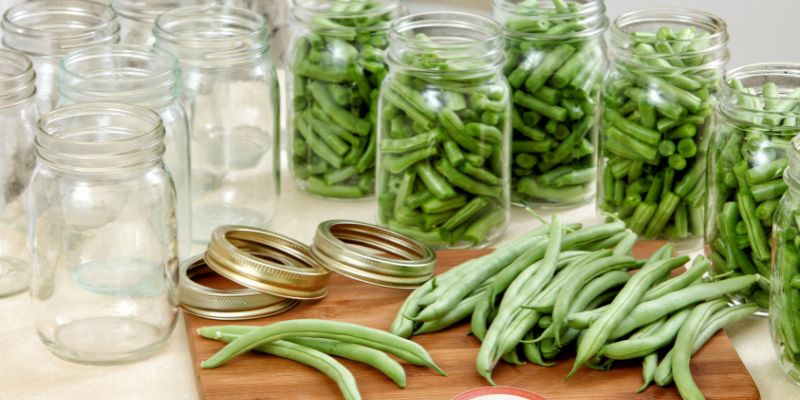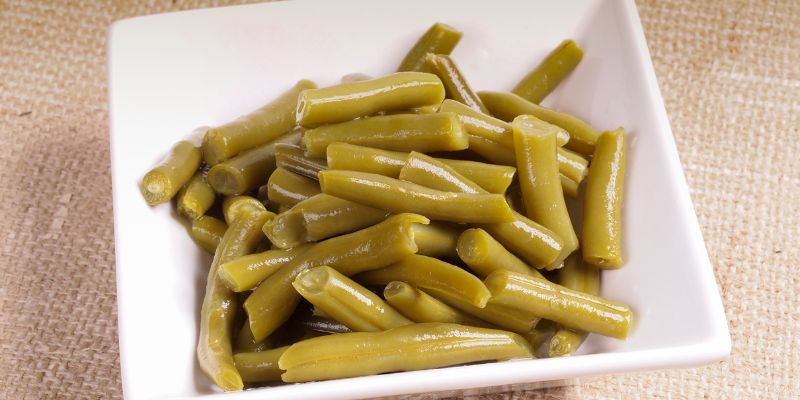How To Store Green Beans: 6 Best Ways To Keep Them Fresh
Sep 01, 2023 By Fabian Forte
Green beans are a versatile vegetable that can be enjoyed year-round, but knowing how to store them properly is key to preserving their freshness. Green beans are best when eaten soon after harvesting. But with the right storage methods, you can keep them fresh and crisp for up to 2 weeks.
Properly storing green beans will help you reduce food waste and enjoy their delicious flavor and crunchy texture for as long as possible. Here, we will discuss how to store green beans properly at home.
6 Ways To Store Green Beans Long Term

1. Refrigerate In The Produce Drawer
The best way to store fresh green beans is in the refrigerator produce drawer. Start by selecting fresh, dry beans without any signs of damage or deterioration. Do not wash the beans before refrigerating, as this removes their natural protective layer and causes them to spoil faster.
Store the dry, unwashed green beans in a breathable container or bag. Packing them tightly in plastic can lead to moisture accumulation and mold growth. Place the container in the coldest part of the refrigerator, usually the crisper drawer.
The ideal temperature for storing green beans is between 40-45°F. Fresh green beans can be kept at this chilled temperature for up to 2 weeks before losing their texture and flavor.
2. Freeze Raw Beans
Freezing is one of the best long-term methods for preserving green beans. Start by briefly washing and blanching the beans in boiling water for 3 minutes. Blanching stops the enzyme activity that can cause loss of flavor and texture during freezing.
After blanching, immediately immerse the beans in ice-cold water to stop them from overcooking. Allow the beans to completely cool, drain excess water, and pat dry. Transfer the blanched beans to airtight freezer bags or containers, removing as much air as possible.
Freeze the green beans for up to 12 months at a constant 0°F temperature. The frozen beans will retain their color, texture, and flavor. Frozen green beans are perfect to have on hand for use all year round.
3. Can Green Beans
Canning is an excellent storage method that allows enjoying green beans year-round. Start with tender, fresh, raw beans and wash them thoroughly. Blanch the beans for 3 minutes as you would for freezing. Drain and pat the beans dry.
Fill sterilized glass jars tightly with the blanched beans, leaving 1 inch of headspace at the top. Pour hot water, vinegar, or a pickling brine over the beans to cover completely. Remove air bubbles and clean the rims before tightly putting on the lids and screw bands.
Process the filled jars in a water bath canner for 20-25 minutes at 212°F. This heating process kills any bacteria and creates a vacuum seal. After processing, allow jars to cool undisturbed for 12-24 hours. Check the lids for a concave seal.
Properly canned beans are kept in a cool, dark place for up to a year. Follow USDA guidelines for safe pressure canning green beans and food preservation.

4. Pickle Green Beans
Pickling is a method that infuses green beans with vinegar, salt, and spices to preserve them. Start with fresh, crisp, raw green beans. Wash and trim the ends. Blanch the beans briefly to maintain color and texture.
Bring vinegar, water, salt, sugar, and spices like dill or garlic to boil in a pot. Place the blanched beans into sterilized jars and pour the hot pickling liquid, covering the beans completely. Seal the jars tightly.
Store the pickled green beans in the refrigerator for up to 6 months. The vinegar pH and refrigeration temperature keep the beans preserved. Pickling locks in the crunchy texture and tangy, seasoned flavor.
Use pickled green beans as a flavorful accompaniment to meals, in relish trays, or even on green bean casseroles. The chilled pickled beans should be stored in the refrigerator after opening. Pickling allows you to enjoy the fresh-snapped taste of summer green beans all year long.
5. Dry Them
Drying is one of the oldest methods used for the long-term preservation of green beans. Start with fresh raw beans and wash and trim them. Slice the beans into uniform pieces or leave them whole.
Blanch in steam or boiling water for 3-5 minutes until bright green. Drain and pat very dry. Arrange in a single layer on dehydrator trays or baking sheets. Dehydrate at 125°F for 6-15 hours until completely dried and brittle.
Check for moisture and store when the beans are dry to the core. Keep dried green beans in airtight containers in a cool, dark place for up to one year.
Over time, they may lose some flavor and nutrition but retain their texture well. Rehydrate dried beans by simmering in water or broth until tender before eating.
6. Freeze Canned Beans
Canned green beans are a handy pantry item, but once opened, they only last about 1 week refrigerated before quality suffers. Prevent waste by freezing any leftover canned beans.
Drain the beans from the can liquid and rinse thoroughly under cold water. Pat the beans dry with a paper towel. Portion the beans into freezer-safe containers or bags in the desired amounts for recipes. Remove as much air as possible and seal tightly. Label bags with the date and bean amount.
Freeze for up to 10-12 months at 0°F. Frozen, canned beans retain their texture better than storing in a can in the fridge. Thaw frozen beans overnight in the refrigerator or use them frozen when cooking. Add the frozen beans directly to soups, stews, and casseroles.
Freezing lets you save and freeze extra canned beans in ready-to-use portions, avoiding waste while keeping their flavor and texture intact.
Conclusion
Properly storing green beans is the key to preserving their freshness and enjoying their crisp, delicious taste for weeks. Refrigeration, freezing, canning, pickling, and drying are great methods for keeping green beans on hand year-round.
Each storage technique helps maintain the vegetable's crunchy texture, bright color, and nutritional value. With these simple storage tips, you can feel confident knowing your green beans will stay fresh and ready to use anytime a craving strikes.








